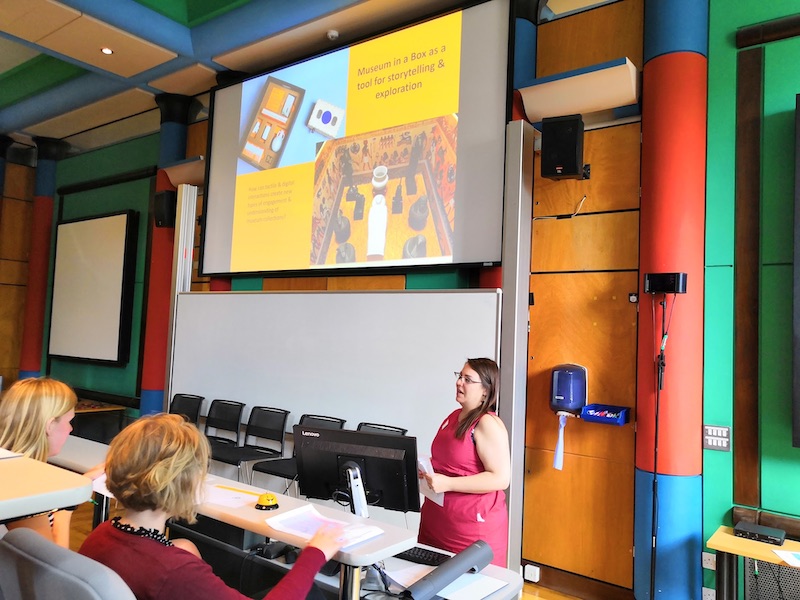
In addition to Helena’s research project ‘Please Do Not Touch?’, underpinning the purpose and theme of the conference was, of course, our AHRC CEEF fellows’ projects. Kicking off this session (in a series of 4 x 10 minute talks) was Dr Abi Glen who is collaborating with creative industry partner Museum in a Box to develop a subscription service of 3D printed objects from the Fitzwilliam Museum’s collection. Cleverly known as ‘sending the Fitz, in bits’, the idea is that small themed collections of 3D-printed objects and paper materials will be snail mailed to consumers to use alongside a ‘Brain Box’ (which is built off a Raspberry Pi). The theme for Abi’s first collection (a favourite pastime for us all!) is food, in keeping with the Fitzwilliam Museum’s next major exhibition “Eat Feast Fast: The Art of Food in Europe 1500-1800” (26 November 2019 – 19 April 2020). Abi will be piloting this project initially in clinical settings, including the dialysis unit at Addenbrookes Hospital (with the support of an Arts and Humanities Impact Fund grant).

I was next up, talking about my Pop-Up Egyptian coffins project where our team from the Antiquities Department have been bringing our cutting-edge, interdisciplinary research into ancient Egyptian coffins into the heart of Wisbech - one of the most deprived towns not only in Cambridgeshire, but the whole of the UK.
What makes this project quite unique, however, is that we have been popping up in surprising locations, such as a supermarket, pub, shopping centre and public thoroughfare, with a range of tactile and non-tactile 3D experiences. This includes real objects, craft replicas, hands-on activities and digital experiences. Since we are focusing on how ancient Egyptian coffins are made, and the industry of their production, therefore, I am working with creative industry partner, ThinkSee3D, to develop a fly-through 3D animation generated from the CT scans of a 3000 year old coffin box to enhance the way people might understand and think about our research findings into coffin construction and reuse in both facilitated and un-facilitated ways. I am also investigating how diverse audience groups in disadvantaged areas engage with all these different types of 3D material and what impact our project has on people’s well-being.

The third speaker in this session was Dr Catriona (Cat) Cooper who both admirably and bluntly confessed her skepticism of 3D printing, explaining her frustrations with the lack of critical engagement over deploying 3D-printed objects in museums. In particular, she questioned why 3D prints are almost fetishized and usually prioritized over other potential alternatives such as craft replicas (a feature of my project above), as well as the assumption that objects used in this way are passive objects lacking in agency and that they can affect people. Thus, to explore these ideas further, Cat is developing a set of good practice guidelines for unfacilitated engagements in museums, underpinned by her collaboration with ThinkSee3D. She is also planning to build on some of the finds from my research, and Helena’s ‘Do Not Touch’ project, to think about how 3D prints are best received and ways in which they might best be used in museum settings.

The final speaker of the session was Dr Jennifer (Jen) Wexler who, like Abi, is working with creative industry partner Museum in a Box. Jen is interested to see how Museum in a Box can be used as a tool for storytelling and exploration around museum collections using the Fitzwilliam’s ancient Mediterranean collections, and the recently launched “Being An Islander” project as its focus. She is keen to explore how we can tell different narrative journeys about how archaeologists study the past and understand connections between islands in the Mediterranean, as well as broader issues around modern island identities. The project is inspired by the work of Winifred Lamb, former Honorary Keeper of Greek Antiquities at the Fitzwilliam Museum (1920-1958) and female trailblazer. Lamb not only created the Greek collection of the Fitzwilliam, but discovered previously unrecorded prehistoric cultures in the Aegean Islands. The project will therefore use Lamb as the guide to the collection, and will use classic museum collection tools such as an old collection box as a sort of mini ‘box of curiosities’ for visitors to explore.
The session concluded with a brief opportunity for questions. Emerging from this was peoples’ curiosity into the role of human mediation and facilitation in 3D experiences – just how important is it to have 3D printed material, for example, explained? Questions also arose about the importance of open access and what measures we are each taking with our projects to make the data generated from our 3D models available for everyone. I pointed out the open access policy we maintain with our Egyptian coffins research, particularly the CT scan and X-radiographic data, as well as conservation studies, but highlighted the issues around storage space and limitations in physically transferring some of this data to other people.
